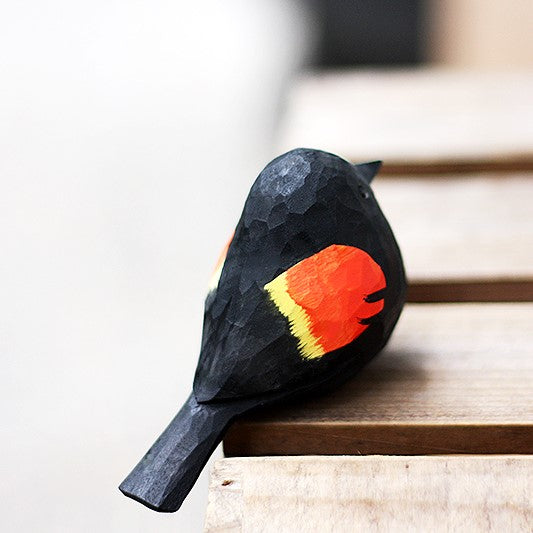
Red-Winged Blackbird Courtship Strategies: How They Attract a Mate
Share
Red-Winged Blackbird Courtship Strategies: How They Attract a Mate
 The Red-Winged Blackbird (Agelaius phoeniceus) is one of the most widespread and recognizable songbirds in North America. Known for the males’ striking black plumage with red and yellow wing patches, these birds have a complex and competitive courtship process. Male Red-Winged Blackbirds must defend territories, sing loudly, and perform visual displays to attract mates. In this blog, we will explore the fascinating strategies these birds use to win over a female.
The Red-Winged Blackbird (Agelaius phoeniceus) is one of the most widespread and recognizable songbirds in North America. Known for the males’ striking black plumage with red and yellow wing patches, these birds have a complex and competitive courtship process. Male Red-Winged Blackbirds must defend territories, sing loudly, and perform visual displays to attract mates. In this blog, we will explore the fascinating strategies these birds use to win over a female.
1. Territory First: Mating Starts with Defending Land 🏞️
Before even attempting to court a female, male Red-Winged Blackbirds establish and defend their territory.
Why Territory Matters in Courtship:
✔ A larger, safer territory means more nesting spots for females.
✔ Males that control the best wetland areas are more attractive to females.
✔ Defending a food-rich area shows strength and ability to support future offspring.
Males aggressively chase away rivals, even attacking much larger birds like hawks or crows. A strong, well-defended territory is the first step in proving worthiness as a mate.
2. The Power of Song: Singing to Impress 🎶
Once a male has secured a good territory, he begins singing to attract females. The Red-Winged Blackbird’s call is a distinct, loud “conk-la-ree!” sound, which can be heard across marshes and fields.
How Singing Helps in Courtship:
- Louder and more frequent songs indicate a stronger, more dominant male.
- The quality and consistency of the song show good health.
- Females listen carefully and choose males with stronger, clearer songs.
Tip: If you hear a chorus of “conk-la-ree!” in a wetland, you are likely hearing multiple males competing for mates!
3. Wing Flashing and Posturing: The Visual Display 👀
The red and yellow shoulder patches (called epaulets) of the male Red-Winged Blackbird play a huge role in attracting females.
How Males Use Wing Displays in Courtship:
✔ Males perch on tall plants or fence posts and spread their wings to expose the red epaulets.
✔ The larger and brighter the wing patches, the more attractive the male is to females.
✔ Males sometimes partially hide their red epaulets when facing off against rivals, only flashing them when needed.
This display signals dominance and readiness to mate, making males with bolder displays more successful in securing mates.
4. The Chase Game: Testing Males’ Strength in Flight ✈️
 Female Red-Winged Blackbirds don’t just pick a mate based on song and color; they also test males through aerial chases.
Female Red-Winged Blackbirds don’t just pick a mate based on song and color; they also test males through aerial chases.
Why Females Engage in Flight Chases:
✔ The chase helps determine if the male is strong and agile enough to be a good mate.
✔ It allows the female to see how well the male defends his territory.
✔ Only the most persistent and skillful males are chosen for mating.
These high-speed pursuits ensure that females select mates with the best genetics and survival skills.
5. Multiple Mates: The Polygynous Nature of Red-Winged Blackbirds 💕
Unlike many birds that form monogamous pairs, Red-Winged Blackbirds are polygynous, meaning one male can have multiple female mates.
How This Works:
✔ A dominant male with a large, resourceful territory may attract several females.
✔ Each female builds her nest separately but stays within the male’s territory.
✔ The male continues singing and defending his area to maintain his group of mates.
Despite having multiple mates, males still provide protection for all the nests in their territory.
6. Nest Selection: Female’s Role in Courtship 🏡
While the male focuses on territory and displays, the female selects the best nesting site for her eggs.
Where Females Build Their Nests:
✔ Inside dense marsh vegetation, shrubs, or small trees.
✔ Near water sources, ensuring access to food.
✔ Hidden among reeds and cattails to protect from predators.
Once a female chooses a site, she begins building her nest, and the male continues defending the area to keep her safe.
7. After Mating: Ongoing Protection & Feeding 🐣
Even after mating, the male’s job isn’t done. He continues:
✔ Defending the nesting area from predators like snakes and hawks.
✔ Chasing away rival males trying to steal mates.
✔ Providing occasional food to the female and chicks.
These ongoing behaviors ensure the survival of both the female and their offspring, making the male’s effort throughout the breeding season crucial.
Conclusion
 The Red-Winged Blackbird has one of the most competitive and strategic courtship processes in the bird world. Males must first secure a territory, sing loudly, flash their red epaulets, and engage in aerial displays to attract a mate. Once they’ve succeeded, they often mate with multiple females, requiring them to continue defending and protecting their territory throughout the breeding season.
The Red-Winged Blackbird has one of the most competitive and strategic courtship processes in the bird world. Males must first secure a territory, sing loudly, flash their red epaulets, and engage in aerial displays to attract a mate. Once they’ve succeeded, they often mate with multiple females, requiring them to continue defending and protecting their territory throughout the breeding season.
If you live near a wetland or open field, take a moment to listen for the conk-la-ree! of a Red-Winged Blackbird—it’s the sound of a male trying to win over his next mate!






